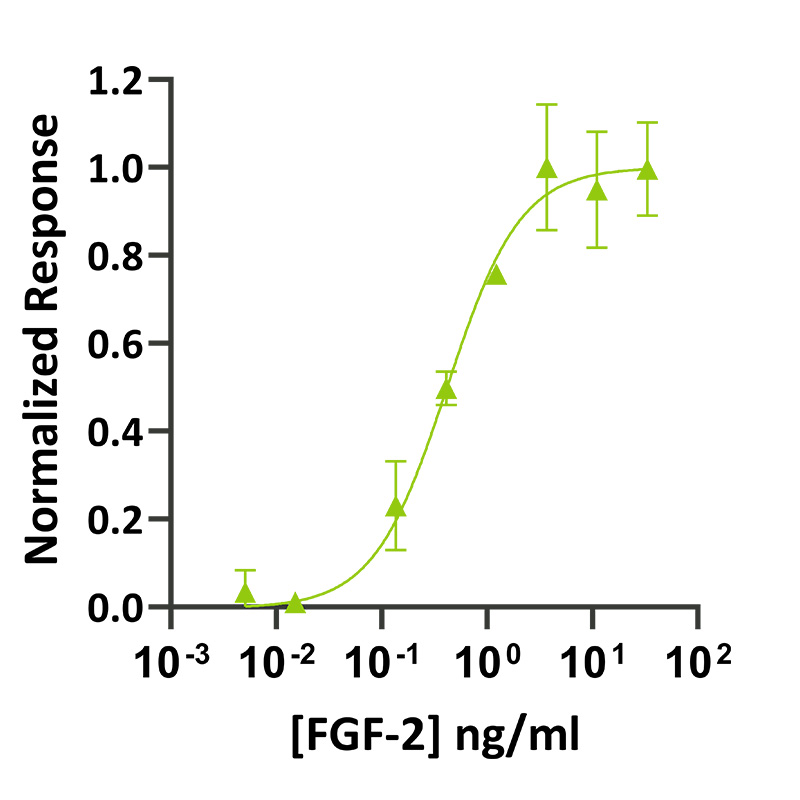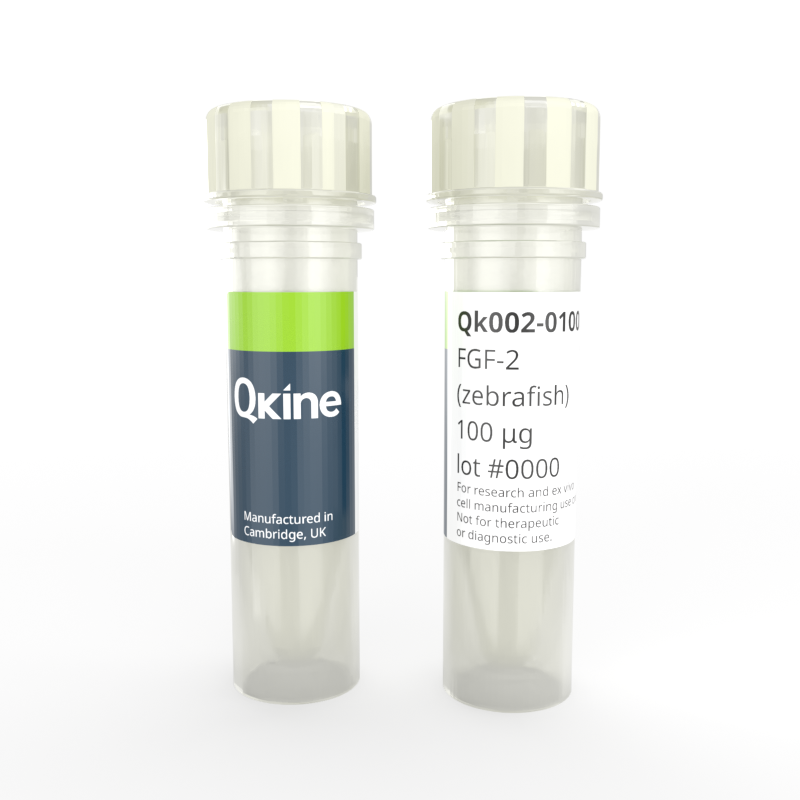 Recombinant zebrafish FGF-2 protein (Qk002)
Recombinant zebrafish FGF-2 protein (Qk002)Recombinant zebrafish FGF-2 protein (Qk002)
Price range: £110.00 through £425.00
Zebrafish fibroblast growth factor 2 (FGF-2/bFGF/basic FGF) has been used extensively to support the maintenance and proliferation of human and mouse induced pluripotent (iPSC) and embryonic stem cells (ESC), used in the original Ludwig et al feeder-free culture of embryonic stem cells protocols.
High purity 17 kDa FGF-2 protein, animal origin-free (AOF) and carrier-protein free (CF). This version of recombinant zebrafish FGF-2 is used by the core facility at the Cambridge Stem Cell Institute, UK and historically by many of the stem cell groups based at University of Cambridge.
In stock
Orders are typically shipped same or next day (except Friday).
Easy world-wide ordering, direct or through our distributors.
Price range: £110.00 through £425.00
Buy online with secure credit card or purchase order. For any questions, please email orders@qkine.com
Summary:
- High purity zebrafish Danio rerio FGF-2/bFGF (residues 2-154, Uniprot: B3DGE3)
- 17 kDa
>98%, by SDS-PAGE quantitative densitometry
Expressed in E. coli
Animal origin-free (AOF) and carrier protein-free
Manufactured in our Cambridge, UK laboratories
Lyophilized from Tris, NaCl, CyS, mannitol
- Resuspend in sterile-filtered water at >50 µg/ml, add carrier protein if desired, prepare single use aliquots and store frozen at -20 °C (short-term) or -80 °C (long-term).
Featured applications:
Stem cell expansion and maintenance

Zebrafish FGF-2 activity was determined using the Promega serum response element luciferase reporter assay (*) in transfected HEK293T cells. Cells were treated in triplicate with a serial dilution of FGF-2 for 6 hours. Firefly luciferase activity was measured and normalized to the control Renilla luciferase activity. EC50 = 0.42 ng/ml (24.7 pM). Data are from Qk002 batch #011 *Promega pGL4.33[luc2P/SRE/Hygro] #E1340
FGF-2 migrates as major band at 17 kDa in non-reducing (-βME) conditions and upon reduction (+βME). The higher molecular mass band at 35 kDa is a dimer that we always see in our highly purified zebrafish FGF2 protein, the presence of this does not affect biological activity. Purified recombinant protein (7 µg) was resolved using 15% w/v SDS-PAGE in reduced (+β-mercaptothanol, R) and non-reduced conditions (NR) and stained with Coomassie Brilliant Blue R250. Data from Qk002 lot #011

Further quality assays
Mass spectrometry: single species with expected mass
Recovery from stock vial: >95%
Endotoxin: <0.005 EU/μg protein (below level of detection)
We are a company founded and run by scientists to provide a service and support innovation in stem cell biology and regenerative medicine. All our products are exceptionally high purity, with complete characterisation and bioactivity analysis on every lot.
Protein background
Fibroblast growth factors (FGFs) are a family of growth factors which regulate a wide range of essential biological functions including cell proliferation and survival, migration and differentiation [1]. The human FGF family has 18-22 members grouped into 6-7 subfamilies based on sequence homology and phylogeny [2]. The FGF family of growth factors have critical roles during both vertebrate and invertebrate embryonic development, in adult cells they modulate tissue maintenance, wound healing and angiogenesis [1,2].
The FGF ligands bind to 4 receptors (FGFR1-4), transmembrane receptors with intracellular tyrosine kinase activity [2, 3]. Once activated FGFRs recruit Src homology-2 (SH2) or phosphotyrosine binding (PTB) domain-containing signaling proteins leading to activation of intracellular signaling pathways [1]. The main signaling pathways activated by FGF binding are the RAS/MAP kinase pathway, PI3 kinase/Akt pathway, and PLCγ pathways [1-3].
Fibroblast growth factor 2 (FGF-2) also known as basic fibroblast growth factor (bFGF) has a broad range of physiological roles including regulation of cell growth, survival and proliferation. FGF-2 is one of the FGFs which binds to and signals through all four of the FGFRs [4].
FGF-2 is an essential growth factor for the maintenance of pluripotency in human embryonic stem cells (ESCs), induced pluripotent stem cells (iPSCs) [4] and mesenchymal stem cells (MSCs) [5]. FGF-2 preserves pluripotency through interaction with PI3 kinase/Akt, ERK1/2, JAK/STAT and PLCγ pathways by activation of activin A. In feeder culture systems FGF-2 stimulates production of essential growth factors and cytokines from the feeder layer [5].
Publications using Recombinant zebrafish FGF-2 protein (Qk002)
-
Distinct Molecular Trajectories Converge to Induce Naive Pluripotency
Stuart HT et al.
DOI: doi: 10.1016/j.stem.2019.07.009 -
Capture of Mouse and Human Stem Cells with Features of Formative Pluripotency
Kinoshita M, Barber M, Mansfield W et al.
DOI: doi: 10.1016/j.stem.2020.11.005 -
A transient modified mRNA encoding Myc and Cyclin T1 induces cardiac regeneration and improves cardiac function after myocardial injury
Boikova A, Quaife-Ryan GA, Batho CAP et al.
DOI: https://doi.org/10.1101/2023.08.02.551469 -
Esrrb guides naive pluripotent cells through the formative transcriptional programme
Carbognin E, Carlini V, Panariello F et al.
DOI: doi: 10.1038/s41556-023-01131-x -
Expanding the apelin receptor pharmacological toolbox using novel fluorescent ligands
Williams TL, Macrae RGC, Kuc RE, Brown AJH, Maguire JJ, Davenport AP.
DOI: doi: 10.3389/fendo.2023.1139121 -
Feeder-free culture of naive human pluripotent stem cells retaining embryonic, extraembryonic and blastoid generation potential
Rossignoli G, Oberhuemer M, Brun IS et al.
DOI: https://doi.org/10.1101/2025.01.17.633522 -
Genome-wide screening in pluripotent cells identifies Mtf1 as a suppressor of mutant huntingtin toxicity
Ferlazzo GM, Gambetta AM, Amato S et al.
DOI: doi: 10.1038/s41467-023-39552-9 -
Human embryonic stem cell-derived cardiomyocyte platform screens inhibitors of SARS-CoV-2 infection
Williams TL, Colzani MT, Macrae RGC et al.
DOI: doi: 10.1038/s42003-021-02453-y -
KLF7 is a general inducer of human pluripotency
Arboit M, Zorzan I, Pellegrini M et al.
DOI: https://doi.org/10.1101/2023.09.06.556189 -
Limited oxygen in standard cell culture alters metabolism and function of differentiated cells
Tan J, Virtue S, Norris DM et al.
DOI: doi: 10.1038/s44318-024-00084-7 -
Oxygen is a critical regulator of cellular metabolism and function in cell culture
Tan J, Virtue S, Norris DM et al.
DOI: https://doi.org/10.1101/2022.11.29.516437 -
Protocol for generating a 3D culture of epiblast stem cells
Rosa VS, Sato N and Shahbazi MN et al.
DOI: doi: 10.1016/j.xpro.2024.103347 -
The transcriptional regulator ZNF398 mediates pluripotency and epithelial character downstream of TGF-beta in human PSCs
Zorzan I, Pellegrini M, Arboit M et al.
DOI: doi: 10.1038/s41467-020-16205-9 -
Inhibition of PRC2 enables self-renewal of blastoid-competent naive pluripotent stem cells from chimpanzee
Huang, T et al.
DOI: DOI: 10.1016/j.stem.2025.02.002
FAQ
Fibroblast growth factor 2 (FGF-2), also known as basic fibroblast growth factor (bFGF) is a growth factor and signaling protein.
FGF-2 is essential for normal embryonic development. It has roles in cell survival and proliferation, angiogenesis, tumorigenesis, wound healing and tissue repair.
FGF-2 binds to and signals though all four of the FGF receptors FGFR1-4.
FGFRs phosphorylate specific tyrosine residues and activate the RAS-MAPK, PI3K-AKT, PLCγ, and STAT intracellular signaling pathways.
FGF-2 is used to maintain the pluripotency of stem cells in culture.
Our products are for research use only and not for diagnostic or therapeutic use. Products are not for resale.
For use in manufacturing of cellular or gene therapy products. Not intended for in vivo applications.

Receive an Amazon gift voucher when you leave us a review.
£25, $30 or €30 for reviews with an image and £10, $15 or €15 for reviews without an image
